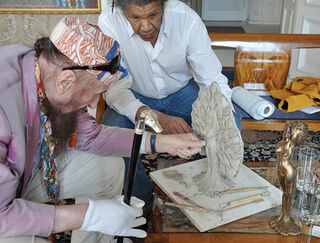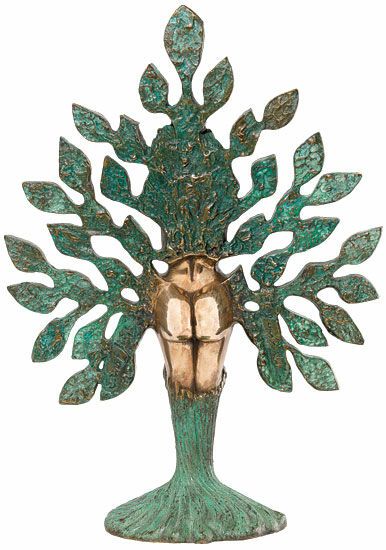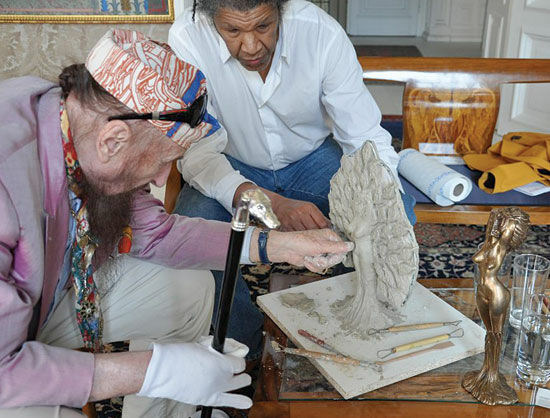Sculpture "Tree of Life", bronze version
Sculpture "Tree of Life", bronze version
Quick info
ars mundi Exclusive Edition | limited, 299 copies | numbered | signed | edition in bronze | patinated | polished | size 30 x 42 x 11 cm (w/h/d) | weight 7.4 kg
Detailed description
Sculpture "Tree of Life", bronze version
The "Tree of Life" by Fuchs and Askew
It was a request to Ernst Fuchs that initiated the creation of the "Tree of Life". The purpose of the sculpture was originally to serve as an award for people worldwide who had rendered outstanding services to the preservation of forest areas. When Fuchs finally had created the first drafts, the client withdrew his order. Fuchs decided to complete the artwork anyway and asked Askew for support with the realisation. Because of the many shared ideas that flowed into the sculpture during its execution, the final product was considered a joint work of both artists.
The "Tree of Life" combines ecological ideas with the mythological-fantastic motifs that are so typical of both artists. The archetypal symbol of fertility and fullness of life already appeared in ancient Oriental art and can be found throughout the art history of antiquity. Even in Indian art, it is a frequently appearing motif. As a symbol celebrating life (and in the Christian interpretation since the Middle Ages also: the resurrection), it has fascinated artists of all times - also of the modern age, think of Klimt's famous realisation in the Stoclet Frieze.
Fuchs and Askew remain figuratively concrete in their Tree of Life: a female torso grows out of the trunk as a symbol of the maternal, life-giving, and is surrounded all over by rich foliage.
ars mundi Exclusive Edition in three versions: Version made of fine bronze, cast using the Lost-Wax-Process, patinated in antique green and partially polished. Limited world edition 299 copies, numbered and signed. Size 30 x 42 x 11 cm (w/h/d). Weight 7.4 kg.
About Ernst Fuchs
1930-2015
Ernst Fuchs, born in Vienna in 1930, already presented his works to the public in 1946/47 together with other young artists during his studies at the Vienna Academy. He was one of the co-founders of the Vienna School of Fantastic Realism.
This art movement emerged in Vienna around 1945 and deliberately set itself apart from abstract art. In their works, the artists dealt with French Surrealism, the experiences of New Objectivity and metaphysical painting as well as the fantastic elements of Viennese pre-war art. Ernst Fuchs' work has had a decisive influence on our understanding of 20th-century art.
The motifs are complex allegories depicting human afflictions between life and death. Biblical and mythological representations dominate. The motifs of the Old and New Testaments are deliberately enigmatic and visionary in expression. These riddles are meant to bring knowledge and solution to the viewer as well as to the artist.
His engagement with the heterogeneous art traditions led him to his historicism. He mixed the styles, sometimes in a polemical way. In his first book, "Architectura Caelestis: Images of the Hidden Prime of Styles" first published in 1964, he set out his artistic conception.
The imaginative pictorial inventions, often alienated by surreal elements, evoke something mystical and often erotic. Fuchs' entire oeuvre is repeatedly permeated by biblical motifs. They all culminate in the unique book, the Ernst Fuchs Bible.
An alloy of copper with other metals (especially with tin) used since ancient times.
When casting bronze, the artist usually applies the lost-wax technique which is dating back more than 5000 years. It's the best, but also the most complex method of producing sculptures.
First, the artist forms a model of his sculpture. It is embedded in a liquid silicone rubber mass. Once the material has solidified, the model is cut out. The liquid wax is poured into the negative mould. After cooling down, the wax cast is removed from the mould, provided with sprues and dipped into ceramic mass. The ceramic mass is hardened in a kiln, whereby the wax flows out (lost mould).
Now we finally have the negative form, into which the 1400° C hot molten bronze is poured. After the bronze had cooled down, the ceramic shell is broken off and the sculpture is revealed.
Now the sprues are removed, the surfaces are polished, patinated and numbered by the artist himself or, to his specifications, by a specialist. Thus, each casting becomes an original work.
For lower-quality bronze castings, the sand casting method is often used which, however, does not achieve the results of a more complex lost-wax technique in terms of surface characteristics and quality.
Graphic or sculpture edition that was initiated by ars mundi and is available only at ars mundi or at distribution partners licensed by ars mundi.
Term for an art object (sculpture, installation), which is produced in multiple copies in a limited and numbered edition according to the artist‘s will.
Artist's multiples have been called the most accessible and affordable art on the market.
A plastic work of sculptural art made of wood, stone, ivory, bronze or other metals.
While sculptures from wood, ivory or stone are made directly from the block of material, in bronze casting a working model is prepared at first. Usually, it is made of clay or other easily mouldable materials.
The prime time of sculpture after the Greek and Roman antiquity was the Renaissance. Impressionism gave a new impulse to the sculptural arts. Contemporary artists such as Jorg Immendorf, Andora, and Markus Lupertz also enriched sculptures with outstanding works.












